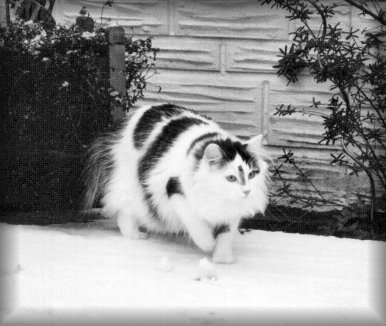
The Norwegian Forest Cat is truly a natural breed and really does originate from Norway. The exact origins of the Forest Cats will never be precisely established, but one thing is certain: NFCs can be found in Norwegian folklore, where it is said that these cats were the family pets of the Vikings. As early as the sixteenth century such cats were described as being large, with long legs, big ruffs and ear tufts. Just like the Forest Cats of today, they had a particular liking for water, with the ability to catch fish in lakes and streams. In some folk tales they are referred to as the "Fairy Cat" - it is easy to imagine them appearing supernatural as they flitted amongst the trees with their long, elegant bodies and flowing, bushy tails. These are the cats that explored the world with the Vikings, protecting the grain stores on land and sea, and which are believed to have left their progeny on the shores of North America as a legacy to the future.
The Forest Cat was presented to the CFA Board for registration acceptance in February 1987, and in 1993, these wonderful works of art from nature were accepted for full championship status.
The Norwegian Forest Cat as we know it today has developed through natural selection, as only the toughest cats with the thickest waterproof coats and other special features would be able to survive in Norway's harsh climate. However, they probably crept in to keep warm by the farmers' hearths when they could, and have always been known to like being around people. Eventually, as the remote areas of Norway became more heavily populated the breed was in danger of dying out, so a special breeding programme began. Since then the breed has gone from strength to strength and is now extremely popular in many countries, particularly Scandinavia.

Of course their personalities differ, depending upon the type home in which they spend their early kittenhood. As with any other breed, a kitten handled and petted by many loving people from birth and which has been exposed to children, cats and dogs will be different from one born and raised in an isolated area with limited human contact.
Bright emerald green eyes with a band of gold. Long flowing hair. Sweet-expressioned faces. Jaunty ear and toe trimmings. Each time you see a Norwegian Forest Cat is a feast for the eyes. Each time you touch their spun-silk soft coats is a delight to the fingertips. These lovely cats are really two for the price of one, they can differ so greatly in looks from summer to winter. Some time in the spring they take off their “winter underwear,” the downy undercoat that provides warmth, and the long non-tangling outer guardhairs that act as protection from rain and snow. The contrast can be quite extreme. The inner-ear hair that deflects the wind and snow (and can be three to four inches long, curving out and around the ear like flexible racing stripes) remains all year. The tail is always magnificent, being as much as twelve inches or more when fanned to its fullest. Perhaps the most impressive part of the coat is the mane. On a fully mature cat, i.e. one over five years of age and which is challenged by the most adverse cold weather, the mane is nothing less than spectacular. It is long, dense and very, very impressive! This, unfortunately, may disappear in the spring, but rest assured that it will begin to lengthen again as the days begin to shorten.
References:
CFA, Breed profile: Norwegian Forest Cats (http://www.cfa.org/breeds/profiles/norwegian.html)
GCCF, The Club for Norwegian Forest Cat lovers in the UK (http://www.nfcc.co.uk/index.html)


 留言列表
留言列表


